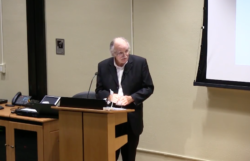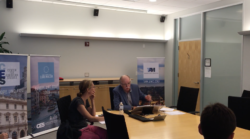Hype & Reality: American Economic Numbers
It is mid-term season in America: time for the Administration to talk up the strengths of the economy. The President did so in Evanston a week ago, wanting “people to know that there are some really good things happening in America.”[1] The worst of the recession is at last behind us. Since in economic terms, it is also bleak mid-winter in the Eurozone, it is additionally time for a little American triumphalism. The Wall Street Journal reported the IMF forecast that way on October 7: a one-in-three chance of return to recession in the Eurozone, only a one-in-seven chance here.[2] The Europeans are doing badly. We are doing better. The American economy is turning around. There are good times ahead for all of us here in America.
Really? Oh that it was that simple: but it is not. The view from the top of the American economy, and the view from the bottom, are still miles apart. If we are to grasp fully the current strengths and weaknesses of our economic position, it is vital that we go beyond the hype.
I
From the top, looking at the economy using the standard indicators coming out of Washington, the signs all look positive. After all, the rate of economic growth is up, rebounding strongly from the winter doldrums, with the overall economy growing at a 4.2 percent annual rate of growth in the second quarter of 2014.[3] The rate of unemployment is down, now officially under 6 percent for the first time since the financial crisis of 2008 – and down now mainly for the right set of reasons: less than because people have stopped looking for work, more because the economy added nearly a quarter million jobs in September alone,[4] in the process putting 2014 on pace to be the “best year for job growth since the 1990s.”[5] The number of job openings across the US reached a thirteen-year high in August;[6] and the overall trend of job creation, up from around 2.1 million new jobs at the start of the year to 2.6 million now, is the highest since April 2006.[7] Median income is rising again (up 3.8 percent to $53,891 in June),[8] underpinning a modest surge in consumer spending and borrowing. By mid-2014 credit card borrowing was expanding at an annual rate of 7.4 percent, and borrowing on cars and student loans at 10.6 percent: this in an economy in which wo-thirds of whose growth depends on consumer spending.[9] Indeed “the net worth of American households is now 20 percent higher than it was before it began to decline in 2007, the Federal Reserve reported” in September.[10] Adjust that figure for inflation, and the net worth of American households is still 4 percent higher than it was before the financial crisis, one reason perhaps why September 2014 was the month when “at last more consumers say they are better off than a year ago than [say they were] worse off.”[11]
So is everything in the economic garden now smelling like roses? Sadly, the answer still has to be “no.” Seen from below, the state of the economy seems significantly less buoyant than the data released regularly in Washington might lead us to suppose.
II
It is true that the rate of economic growth has quickened, but that rate is still low by pre-recession standards. In July the IMF actually cut the US growth forecast for 2014 to just 1.7 percent,[12] the CBO’s in August was just 1.5 percent.[13] These are not stellar growth numbers. The official rate of unemployment is falling, and jobs are coming back: but the numbers flatter to deceive. Too great a part of the improvement in the unemployment numbers reflects a shrinkage in the labor force seeking employment – down 97,000 again in September – leaving the overall labor market participation rate at less than 63 percent, the lowest since 1978.[14] In December 2007, the participation rate was 66 percent. Since then, 8 million Americans have simply dropped out of the labor force. Had they stayed, the unofficial unemployment rate would be nearly double its current level.[15] The number of long-term unemployed remains high (at 3 million) and so too does the number of those only able to find part-time employment (at 7.1 million). And the rate of job growth still falls short of the numbers required to match labor force growth. The September job creation number (at just under 250,000) is one of only six months of such job growth since 2008. In the 1990s, there were 47 such months, one reason why “the Hamilton Project estimates we will not reach our former level of employment, when factoring in new labor-force entrants, until mid-2019.”[16]
Then there is the issue of the quality of the jobs being created: the bulk are in low-paying sectors, not in manufacturing. In September, leisure and hospitality added 33,000 jobs. Retail added 35,000. Employment in manufacturing, by contrast, flat over the last three months, added just 4000 jobs. This helps explain that most intriguing of trend-lines in the current US economy: job creation rising, but wages – for the vast majority of Americans – remaining stuck: and where they are rising, still on catch-up from their levels in 2007.[17] The median income may now be going up, but it is still short of its 2007 peak (of $55,589) by 3.1 percent:[18] indeed, there were 36 states in the Union, plus the District of Columbia, that saw no rise at all in the median income of their citizens between 2012 and 2013.[19] That was in part because overall, half of all the jobs lost during the post 2008 recession were in high-paying manufacturing and construction, while since 2010 the fastest growing employment sectors have been the low-paying accommodation and food sectors. The result: “the annual wage in sectors where jobs were lost during the downturn was $61,637, but new jobs gained through the second quarter of 2014 showed average wages of only $47,171. This wage gap represents $93 billion in lost wages.”[20]
So the squeeze on the middle-class is still on, inequality remains entrenched and poverty is still a daily reality for far too many Americans. The Center for American Progress’s recent report on middle class living standards contrasted stagnant wages with rising costs. As they put it, “the costs of key elements of middle-class security – child care, higher education, health care, housing and retirement – rose,” for a family with two children, “by more than $10,000 in the 12 years from 2000 to 2012, at a time when this family’s income was stagnant.”[21] Meanwhile, if the data from the Federal Reserve’s tri-annual Survey of Consumer Finances is correct, the rich continued to do very well: “incomes rose nicely in the 2010 to 2013 time frame for the top 10 percent of earners (who had a median income of $230,000 last year). They rose slightly, by 0.7 percent, for the 80th to 90th percentile of earners (median of $122,000). But real incomes fell for every other group of earners.”[22] For the second year in a row, indeed, the 14 richest Americans earned more from their investments than the entire federal Food Stamp budget now helping 50 million Americans![23] This, in a year when the American Community Survey showed that “poverty rates were essentially unchanged from 2012 to 2013 in virtually every state;”[24] and a year in which – with 2.1 job seekers for every available job opening – the historically low figure of less than 30 percent of the long-term unemployed still had access to unemployment Insurance.[25] No wonder, then, that Federal Reserve Chair Janet Yellen could tell a Washington conference in September that she remained concerned that “the large share of American families remain extraordinarily vulnerable to economic catastrophe.”[26] Little wonder too that, for all the hype about improving American economic performance, many Americans (anywhere between a third and a half) remain ‘unhappy, worried and pessimistic…in the aftermath of the Great Recession.”[27]
III
Currently, the Eurozone may well be struggling more. Certainly its core engine of growth, the German economy, now teeters on the edge of recession, the casualty of its own government’s excessive enthusiasm for austerity and retrenchment in its key southern European markets. But as we bemoan Europe’s problems, it is worth recognizing the scale and depth of our own; and it is worth remembering too, amid all the European gloom, that workers in the United States still work, on average, anywhere between 250 and 400 hours a year more than in their equivalents in Western Europe. 250-400 hours is no less than “an additional six to ten weeks of work a year.”[28] High-wage, low-hours Western Europe may now be struggling; but low-wage, long-hours America is not doing that much better.
Several things seem to follow. One is that the recovery of the US economy from the recession is at best patchy and that its benefits are still very unevenly distributed. A second is that we could all do with a lot more honesty and soul-searching on this both in Washington and beyond. A third is that we will never fully recognize the depth of the economic and social failures going on around us if we continue to measure something we call economic success by simple market-based numbers alone. A fourth is that this is no time to crow about US superiority. Times are bad, for far too many people, on both sides of the Atlantic. As Christine Lagarde, the Director of the International Monetary Fund, put it earlier this month, if public policy does not radically improve, the entire “global economy could be stuck on a ‘new mediocre’ growth path with high debt and unemployment.”[29]And mediocrity is an economic condition that none of us should tolerate, let alone praise.
[3] http://www.reuters.com/article/2014/08/28/usa-economy-idUSL1N0QY0RS20140828
[4] http://blogs.wsj.com/economics/2014/10/03/behind-the-u-s-jobless-rate-more-job-gains-than-dropouts/
[5] http://www.nytimes.com/2014/10/04/business/economy/monthly-jobs-report-september.html
[6] http://online.wsj.com/articles/number-of-job-openings-hits-13-year-high-1412732865
[7] http://bigstory.ap.org/article/us-economy-forecast-grow-15-percent-2014
[8] http://money.cnn.com/2014/08/20/news/economy/median-income/
[12] http://online.wsj.com/articles/imf-cuts-u-s-2014-growth-forecast-to-1-7-1406131238
[13] http://bigstory.ap.org/article/us-economy-forecast-grow-15-percent-2014
[15] http://online.wsj.com/articles/william-galston-saving-the-vanishing-american-worker-1410908001
[17] http://www.epi.org/blog/modest-income-growth-2013-barely-begins/
[18] http://money.cnn.com/2014/08/20/news/economy/median-income/
[19] http://www.epi.org/blog/states-modest-improvements-incomes-start/
[21] http://www.americanprogress.org/issues/economy/report/2014/09/24/96903/the-middle-class-squeeze/
[22] http://www.americanprogress.org/issues/economy/report/2014/09/24/96903/the-middle-class-squeeze/
[24] http://www.epi.org/blog/acs-data-show-improvement-state-poverty/
[25] http://www.epi.org/publication/historically-small-share-jobless-people/
[26] http://www.thefiscaltimes.com/Articles/2014/09/18/Yellen-Says-Many-US-Families-Edge-Disaster
[29] http://www.reuters.com/article/2014/10/02/us-imf-lagarde-idUSKCN0HR1UT20141002
Tags: economic growth, economy, eurozone, inequality, job creation, labor market participation, median income, poverty, squeeze on middle class, unemployment, wages
David Coates holds the Worrell Chair in Anglo-American Studies at Wake Forest University. He is the author of Answering Back: Liberal Responses to Conservative Arguments, New York: Continuum Books, 2010.
He writes here in a personal capacity.





